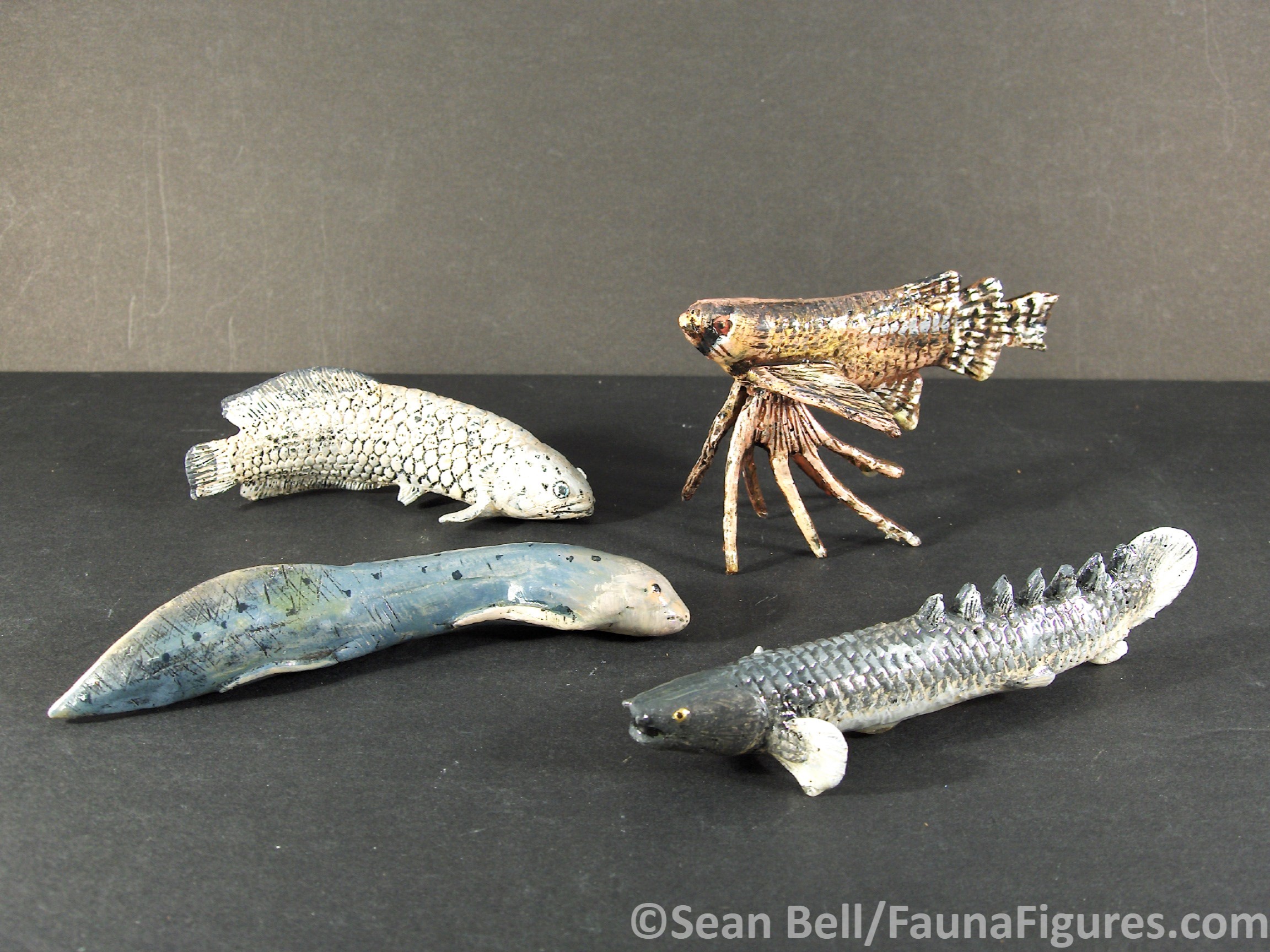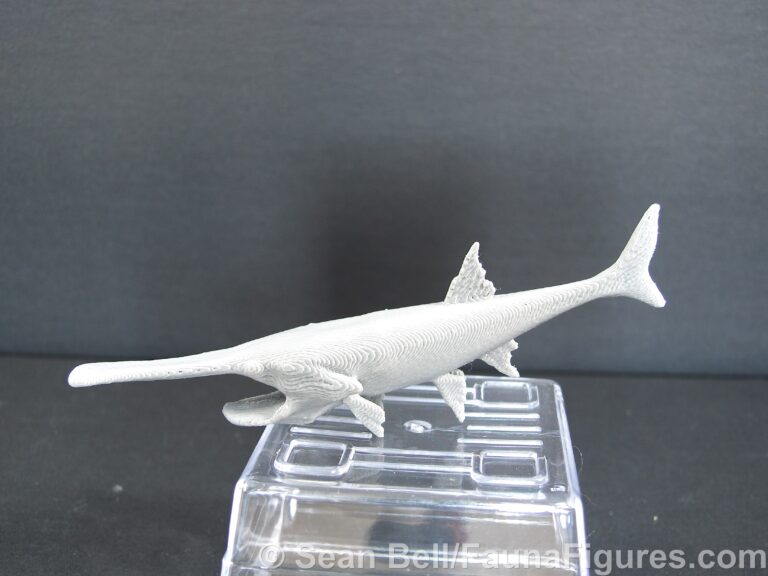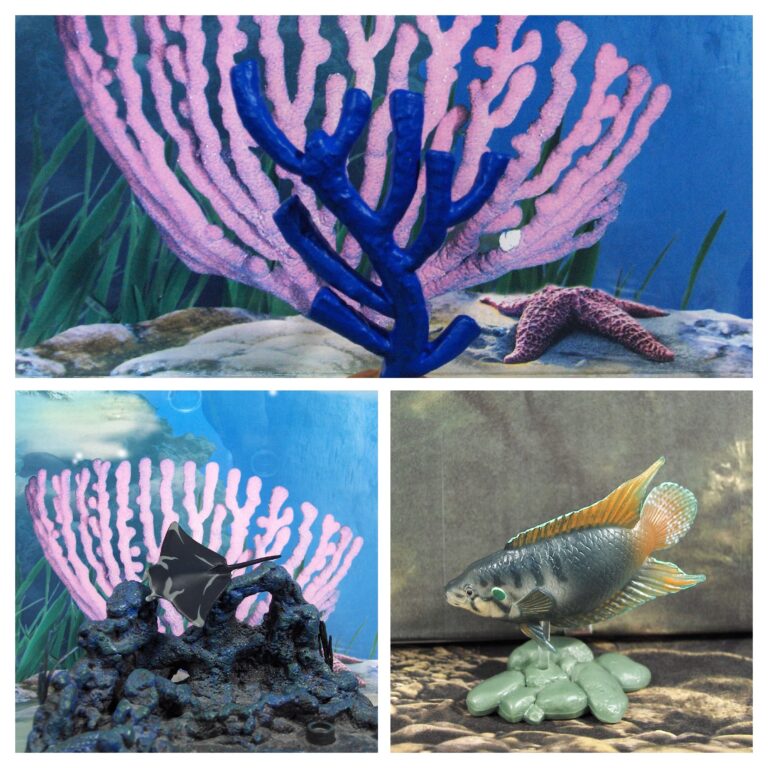Welcome to post 100! A milestone number! And I thought I should do something different, and kind of special–so I will go over all of the figures from my original line of fish figures, made for my store! The FaunaFiguresFishes were sculpted and cast for by a sculptor named Brandon DeMoss. The first of the original waves were produced in 2016, the last one came out in late 2018. A couple of other figures were later produced in a new format but they were made as individual figures by Brandon.
We made 4 series for a total of 13+1 species, but time and life got in the way of continuing the line further. The runs were also fairly small, again because of their handcrafted nature. The species were chosen by me, based on ones that I have always wanted to see made–and with one exception, the figures made are still the only representative figures made so far. The figures also primarily featured freshwater fish, mainly because their diversity on the whole seems too limited to me! Finally, they were also made to be similar in size, kind of to line up with Colorata and other smaller size figures.
So now we can go through the four series–and you’ll see a couple of specially made figures!
WAVE ONE: AFRICAN FISH

The original run of the African fishes was actually just three species–the lungfish, bichir and butterflyfish. While we were working on wave 2, a suggestion/request was made for the African bonytongue. We received lots of suggestions (worldwide there are so many fishes, especially freshwater fishes, that have fans that need figures) but this one came from a fellow fan of primtive fishes, so the decision was made to add one more (it was on our list anyway). Which is great, because we might not have had it otherwise (we would have circled back through the continents again if we’d been able to keep going). They were also the first fish that Brandon had sculpted (other than some tiny accessories for other animals) so there was some learning (for example, make sure to check out his later version of a bichir compared to the one in this set–which was the very first model of all.
Polypterus senegalus GREY BICHIR FF-001
It was a given, when I was getting this series put together that I would make sure a bichir would be in it. I have been into these species of fish since I was 12, which was never-you-mind years ago. Of course I’ve had several live ones as pets (I currently have two). I always found them fascinating, but was disappointed by the number of figures–and even more so by the available species (even today, the only commercially available species is and has ever been Polypterus endlicheri, all from Japanese makers). So we made one of the more common ones with a relatively straightforward colour palette since, again, first time attempt at a fish model! It is a little rigid, one of the main reasons that the newer model was made.
Pantodon buchholzi AFRICAN FRESHWATER BUTTERFLYFISH FF-002
With an opportunity to do some interesting fish from Africa, this one is another personal favourite, one I have also kept a few times. They are so unique and weird looking–it just seems like it would make a good figure. And I think Brandon really nailed the look of this fish, even the trailing fin rays (which, yes, are a little thick–it’s a materials thing). Sadly, after the original 5 copies were cast the mould was unusable–so there are only 4 more of this figure anywhere in the world.
Protopterus annectens WEST AFRICAN LUNGFISH FF-003
There are so many lungfish figures out there…but they are ALL Australian lungfish figures (order Ceratodontiformes). So I really needed to fix that. We went with West African lungfish because it’s such a typical species. The figure turned out very well I think. Again, how is there no other figure of this species…or family…or even order (Lepidosireniformes) of lungfish? Not only are they really interesting and unique animals, but they’re really cool from an evolutionary standpoint.
Heterotis niloticus AFRICAN BONYTONGUE FF-004
The figure created by outside request! We did want to make one (of the figures in the African series, it’s the one I’m least familiar with). But we were asked at just the right time, while new sculpts were being made anyway. Unlike it’s far more popular relative, the Arapaima of South America, I don’t think African bonytongues get much attention. Certainly not as a figure. I’m glad someone made that request, otherwise we wouldn’t have one at all!
Special Release figures: Protopterus aethiopicus MARBLED LUNGFISH FFF-003A AND Polypterus senengalus ALBINO GREY BICHIR FF-001A
From the first series, we had a couple of special issues of figures, based on requests. Specifically, requests from my kids. We had a pet albino Senegal bichir at the time (RIP Scipio…impacted intestine problem) and my daughter wanted a version for herself. It could probably use a slight yellowish wash but it made her happy! My son requested the lungfish in the leopard-pattern. Seeing as the overall body appearance is similar, it was a matter of a new paint application on the original sculpt. Unlike the bichir, Brandon actually produced a few of the marbled lungfish models, so while some people who have FaunaFiguresFishes models have rare things, some are even more rare (I want to say there were 3 total)!
WAVE TWO: NORTH AMERICAN FISH

Seeing as I am from North America, it was probably a given that we would travel there for the next series. It helps that there are some very cool primitive fish from here that really don’t see much attention as figures, so we wanted to fix that. We did our usual 3 species, but this one saw a revised paint job for one of them after a bit of research. This is also a series that has had requests for individual casts–it turns out paddlefish are pretty popular, but not enough for widely-available toys/figures.
Polyodon spathula American Paddlefish FF-004
This is a fish that I really, really wanted a model of. At one point I found a fairly realistic wood decoy, and that was the only Paddlefish in my collection. I have since tracked down or 3D printed several others and would call my assortment of American paddlefish figures probably one of the broadest ever (I even have a single figure of the now-extinct Chinese paddlefish, made as a consigned model). These iconic filter feeding mega-fish of American waterways (and even some of eastern Canada before being extirpated) are unmistakable for any other animal. But when it comes to figures of North American fish things are generally limited to the usual game fish such as trout, salmon, and bass…even other favorites like pike and walleye are almost (but not entirely) unheard of (although you’re more likely to get a perch or carp than a paddlefish or bowfin). So we set out to correct that, and I think it turned out pretty great.
Amia calva BOWFIN FF-006 & FF-006B
The second North American fish was another primitive one that I really, really wanted in my collection…and unlike the paddlefish, bowfin figures did not magically start to appear all over the place for me. I also have a wooden decoy model…and a consigned model (same person as the Chinese paddlefish) and that’s it. They are so widespread and familiar and river monster-y (good enough to be on that show even) that they should get more attention. I am glad that the second run saw a repaint; the green version might have been inspired by breeding colours, but the brown looks more ‘right’ based on the only big one I’ve ever seen alive (in a public aquarium–I live in the wrong part of Canada for them).
Lethenteron appendix American Brook Lamprey FFF-007
For this last North American one, we again went with a primitive fish…a really primitive fish! Again, it seemed that there are no lamprey figures at all (there appears to be one other obscure one from Europe, but I have yet to get it). This seems strange, since they are at least notorious or infamous–since most people are familiar with the parasitic (and sometimes invasive) sea lamprey. I left the choice of species to Brandon–I just said lamprey, he went with the American brook lamprey. Maybe because they are quite shiny and almost gold hued in the right light!? Maybe they’re from around where he lives? Having this figure made was great for me–I always provided an info card with each figure, so I had to learn more about brook lampreys. Turns out, they are not parasitic and the adult form (as produced) doesn’t even eat! So I got to learn something! And that’s just one more reason we need figures of every possible animal!
WAVE THREE: EUROPEAN FISH

Our next wave came from European or European-adjacent fish. This was also our first and only foray into non-freshwater, because we needed a hagfish, and they are the opposite of freshwater fish (being deep sea marine animals). Even the sturgeon is only partially freshwater; being anadromous adults live in sea basins and swim upriver to spawn. And the burbot is not strictly European, as they are found throughout the Holarctic regions of the globe–but there are suggestions that burbot from different regions are different species or subspecies. Anyway, the rules were never hard and fast anyway!
Acipenser stellatus STARRY STURGEON FFF-008
Our first European is was one that represents in other parts of the northern hemisphere, a sturgeon. But specifically a starry sturgeon, which is found Europe, although increasingly less of it. As a group they’re pretty cool, and need more representation, since most people only think of them for their eggs (which is gross and is probably a dare that got out of hand). There are a number of other sturgeon figures out there (Safari just released a Great Lakes toob with a wonderful Lake sturgeon in it) and I have a decent collection, but European ones are not as common (other than a single Beluga sturgeon). Overall, I have to say that inland European fish are pretty neglected as a group–yet at least a few big companies are European and they should fix that.
Myxine ios WHITE-HEADED HAGFISH FFF-009
Next stop is the deep sea fish, the white-headed hagfish. I think Brandon was super excited to make this one, just to create the ‘knot’ body shape. It turned out really well too. I did have people ask if they could add slime…I wouldn’t recommend it personally due to the acrylic paint, even once sealed (back in the 90s there was apparently a toy set featuring a rubber hagfish and add-water goo in a bucket. I will never stop hoping it will be re-released). This is another one that grabbed people’s attention, requiring a few one-offs for people! It would be nice to see hagfish show up more, there are lots of deep-sea sets, why not include one of these?
Lota lota BURBOT FFF-010
And finally a burbot. As a group cod are pretty unrepresented as figures, even though they have had a pretty out-sized importance economically! But, in keeping with our generally freshwater theme, and because I’ve actually been around burbot, we went with it. The chin barbel was a bit of a challenge because of how thin it is (on mine, the barbel was actually broken off but I reglued it. The okay ones went to other people) but they seemed to stay together okay. It’s another fish that could actually stand to be reproduced in a soft squishy rubber, they’re almost surreal to touch (after handling trout and suckers). I have a fishing lure version because it’s hilarious, but I would like an actual figure/model/toy.
WAVE FOUR: SOUTH AMERICAN FISH

The final wave produced was short-lived just because of timing–some South American favorites! Despite the Amazon, and South America in general, being loaded with so many cool freshwater animals (not just fish) there’s a downright shocking lack of representative models. Other than Arapaima and Piranha, there are only a few that have been made even once (I have more than most people of course, but it’s still pretty limited). A few characins, a few catfish, a couple cichlids, a couple Osteoglossum arowana, some other oddities…it seems pretty underwhelming. So we gave a shot to a few excellent other ones!
Lepidosiren paradoxa SOUTH AMERICAN LUNGFISH FFF-011
First off, we had to go with a South American lungfish. The OG lungfish (it’s genus name is also the order name!). Like the West African lungfish from wave 1, this is the only South American lungfish figure–there are very few people can actually claim to have the trifecta of modern genera represented as figures (there are quite a few Australian lungfish). I like the active, almost rising pose for it, although it is tricky to make sit up. Maybe it needs a base? Anyway, I am really glad we got far enough to get this one made!
Potamotrygon motoro SPOTTED RIVER RAY FFF-012
I have often made my affection for fish well known, but I don’t think I’ve had a chance to talk much about how much I love rays. The famous Sea Flap-flaps often overshadow their freshwater cousins, but I really like the freshwater ones. They have such beautiful patterns, and are relatively accessible (I tried to keep them years back with no success, but I have seen many happy ones since). And the motoro was always a favorite–so we decided to go with that one! As a group, rays are usually represented by a limited number of figures (sawfish, shark ray, eagle ray, manta, generic stingray, generic skate) so it would be nice to see the broader range of this weird group in model form–including the various freshwater ones from around the world.
Apteronotus albifrons BLACK GHOST KNIFEFISH FFF-013
Okay, so technically there is a ghost knifefish figure out there. But this one is intentional, while that one was forced (labelled as an eel, clearly more of a gymnotiforme…) Another striking species that is also pretty familiar with many people. I had been around them a lot, but never realized how large they could get! It’s also an odd one to end the series on, but it made for a nice figure. Once again, it seems somehow strange that animals like this, which are often familiar through public aquaria or home aquaria, don’t seem to get much attention as models. It would probably also really help bring awareness of fish diversity, and freshwater diversity.
So on that note, I thank you for reading over the history and breadth of the series. Maybe it would have been nice to continue but it doesn’t always work that way. For those wondering, there were plans for an ‘SE Asia set (I think sculpts were initiated) featuring a Fire eel, Clown Featherback and Palauan Primtive Cave eel but things didn’t work out for that. And then some Australians, even Antarctic ones, and back around again through the same places more or less. I suppose the good news is that I don’t think any of the species we decided on have been done yet so maybe it could still happen. Or, if anyone wants to find a way to make it happen…I’m still here!
On another note, I really like this layout and will probably use it more in the future…
















































